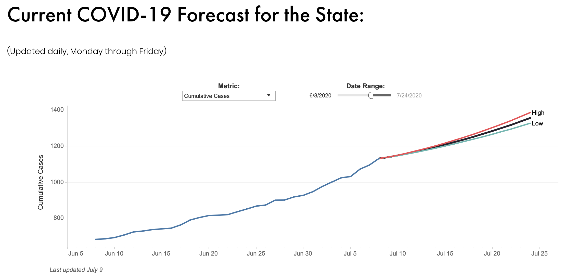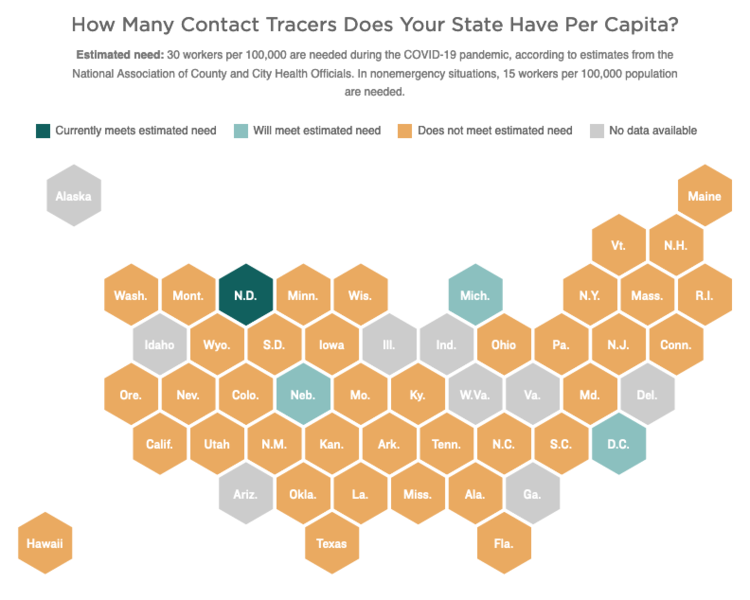News & Updates

Instead of Relying on Stories, We All Need Access to Better COVID-19 Data
The potential of data lies not in its ability to reinforce stories — that leaves us reliant upon the storytellers. Instead, comprehensive and readily available data facilitate conversations that allow the broader community to see exactly what is happening and, if necessary, question assumptions about our current situation and what lies ahead. Over the last two weeks, it has become clear that state and county leadership do not have full access to the data and expertise needed to manage the disease. And neither does the public.

The Importance of Leading and Lagging Indicators for Ongoing Monitoring of COVID-19 in Hawaii
While it likely makes sense to most of us that these indicators measure different components of COVID-19 management – i.e. new cases, daily test rates, hospitalizations, etc. – it might be more difficult to understand how they all fit together, and why it is important to have a balance of indicators that represent the range of relevant factors for managing COVID-19 locally. One important frame to consider is distinguishing where data points fall along the continuum of leading to lagging indicators.

HiPAM Launches New Daily COVID-19 Forecast Tool for Hawaii
The Hawaii Pandemic Applied Modeling (HiPAM) work group has launched a new public-facing tool that provides 14-day forecasts of new COVID-19 cases, hospitalizations and fatalities. The tool will be updated daily (Monday through Friday) based on the most current COVID data available in the state.

Hawaii Appleseed's Gavin Thornton Discusses $100 Million CARES Act Housing Support for Hawaii's Families
Gavin Thornton, Executive Director of the Hawaii Appleseed Center for Law and Economic Justice, discusses recent legislation passed that will provide $100 million of CARES Act funds to folks in need of rental and mortgage support, and why this assistance is necessary to shield the state from even greater costs in the future.

Fly on the Wall: A Glimpse into Developing a COVID-19 Modeling Tool for Hawaii
During a HiPAM convening, the group discussed how to respond to requests from local decision-makers for models and metric guidelines that would help determine when to lift local and domestic travel restrictions, as well as indicators of when restrictions may need to be re-imposed. The subsequent discussion demonstrated the complex array of factors that our state officials and senior executives must consider…

Dr. Thomas Lee, HI-EMA's Lead Modeler & Forecaster, Discusses Reopening Hawaii to Travel and More
Dr. Thomas Lee, Assistant Professor of Epidemiology at the University of Hawaii at Manoa, also an US Army Medical Officer from the 1984th US Army Hospital Pacific, 9th Mission Support Command, currently serving as lead modeler and forecaster for Hawaii’s Emergency Management Agency (HI-EMA) COVID-19 Emergency Response Team, discussed how he applies modeling to forecast and advise policymakers in their decisions, the potential and efficacy of testing and screening of inbound travelers, a basic explanation of “R naught,” and more.

Anonymized Testing Outcomes Database (ATOB) Could Increase Precision of Reopening Policies in Hawaii
An anonymized testing outcomes database (ATOB) that provides daily aggregated counts of asymptomatic as well as symptomatic cases could save Hawaii an additional $300 million in economic costs over non-ATOB reopening strategies.

Finding the Trade-Off Sweet Spot: Relatively Modest Health System Investments Could Reduce Hawaii’s Economic Losses by Billions
We used our Hawaii Population Model to explore the interplay between the medical resources needed to combat COVID-19 and their associated economic impacts, given current conditions over the next two months. We ran scenarios of every possible combination of health system parameters, with their associated economic costs, iterating and reiterating the model until every combination of infection mitigation strategies had been tested.

Contact Tracing versus Contact Tracking
Among the many new terms that have crept into our daily language, contact tracing has become one of the most frequently heard in connection with COVID-19. Contact tracing is a traditional public health strategy that has been used to fight the spread of everything from the common flu to the AIDS virus. We often hear public health officials talk about the need to employ contract tracing to not only get the current pandemic under control but to keep the virus from flaring up once we start to reopen cities and states.

COVID-19 Highlights Vulnerabilities of Rural Hawaii
After an initial delay, cases in rural communities have climbed throughout the country. On March 6, COVID-19 first emerged in Hawaii on its most densely populated island of Oahu. Cases followed in mid-March and early April on the state’s neighbor islands, home to the Hawaii’s more rural areas. As of April 19, 2020, Hawaii Island reported 62 COVID-19 cases; Maui (including Molokai), 106 cases; and Kauai, 21 cases, compared to Oahu’s 385. Although the majority of cases in the state remain on Oahu, the slow and steady growth of confirmed COVID-19 infections on neighbor islands confirms that they are susceptible to the disease as well.

Local Expert-Driven COVID-19 Models for Hawaii Are Long Overdue
We learned the hard way that modeling COVID-19 forecasts is not one-size-fits-all. Recently, we wrote about the advantages of the University of Washington IHME model for understanding peak hospital demand in Hawaii, only to shortly thereafter advise caution in interpreting the model because the projected hospital capacity peak had suddenly shifted by three weeks [link]. A closer inspection of the model revealed problematic assumptions, and underscored a real vulnerability for Hawaii in not having a valid local model.
[Updated] Can Hawaii's Hospitals Meet Peak COVID-19 Demand?
We have been working to evaluate multiple modeling tools for projecting peak hospital demand and capacity sufficiency in Hawaii. The University of Washington (UW) Institute for Health Metrics and Evaluation (IHME) model was identified as best suited for projecting Hawaii hospital capacity in the coming weeks.
